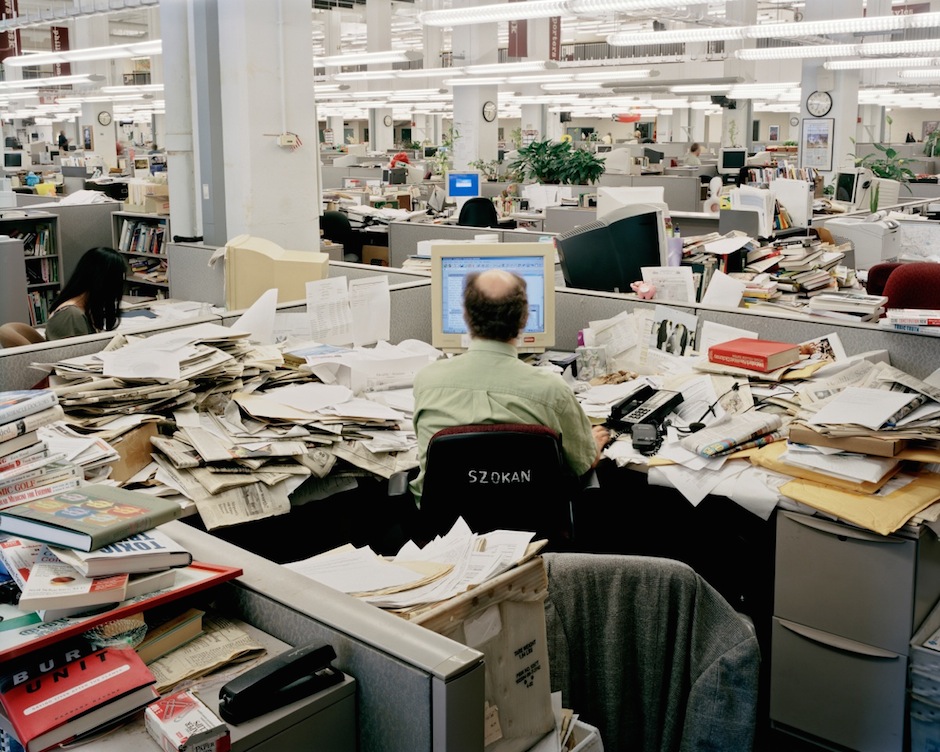Will Steacy: Chronicling Difficult Times at the Inquirer and Daily News

“DON SAPATKIN, DEPUTY SCIENCE & MEDICINE EDITOR, 6:44PM, 2009” by Will Steacy. Used with permission.
Will Steacy isn’t a newspaper man, but he comes from a long line of them: Five generations’ worth — including an ancestor who started The Evening Dispatch in York nearly 140 years ago, and his own father, Thomas, a former editor at The Philadelphia Inquirer who was laid off in 2011. “Since I am not in the newspaper business, I fear that this tradition will now come to an end,” he says.
Not that he isn’t an experienced media hand. While his father was still with the paper, Steacy began what turned into a five-year-project to photograph workers at the Inquirer and Daily News as they struggled with layoffs and other changes wrought by the collapse of the industry.
He’s now attempting to turn that project into a book — Deadline — and raising funds to complete it through Kickstarter.
In addition to the completed book, backers can earn rewards ranging from “If it bleeds, it leads” pencils to historic copies of Philadelphia newspapers. (As of Wednesday night, a few days before the August 19th deadline, Steacy had just exceeded his $15,000 goal for the project.)
Via email, Steacy discussed the project with Philly Mag this week:
How did you get started on this project? Did you know you’d be depicting the newspapers in decline, or did you have something more general in mind?
I began this project in 2009 as the Inquirer was just reemerging from bankruptcy and my intention was to document a newsroom fighting through hard times while simultaneously undergoing a massive industry-wide transition into a digital era. The newsroom certainly has fought through hard times and continues to do so, producing the best journalism they can with the staff and resources they have. And despite the depleted ad revenue, steady decline in circulation, furlough weeks, buy-outs, lay-offs and bankruptcy, the paper has won two Pulitzers in the past three years.
When I began the project, I never expected to watch my father get laid off, I never expected the staff and budget cuts to continue as mercilessly as they did, I never thought the day would come when 400 North Broad Street would no longer be the home of the Inquirer. It has been a long, gut-wrenching journey, but through all of this, I have grown closer to my father.
How did you get such wide-ranging access?
I wrote a letter to the editor describing what I wanted to do and asked for his approval. From day one, he gave me his full support and believed in my work. But getting this sort of access is not always that simple, and surely the scales tilted in my favor by the fact that my father worked at the paper and could vouch for me.
Your time in the newsroom included ownership changes, bankruptcy, the move to new headquarters. How did staffers take the constant run of chaos? How did it affect you?
It has surely been a long and eventful five years. There were surely times when you could feel the stress and anxiety in the air. And there were plenty of times I had to ask myself, “How can the newsroom staff handle all this?” It’s like being backed into the corner ropes, round after round, and taking punch after punch to the gut. But they did. That newsroom is filled with some of the toughest men and women you will ever meet in the newspaper industry. There were certainly times when it was hard and certainly painful on a personal level with my father not there.
Why’d you take this project to Kickstarter? It seems you’ve been industrious and creative in coming up with rewards for contributors.
The challenges facing the newspaper industry are spread throughout the entire publishing industry and so just as high-quality, in-depth journalism requires a financial commitment to cover costs, a beautifully designed and printed photography book requires the same level of fiscal commitment. I wanted to use each of the rewards offered in the Kickstarter fundraiser as a storytelling opportunity. And so for each reward I share a small part of the Inquirer‘s history, my family’s history and our nation’s history as it is depicted on the front page everyday.
At the end, what will this book tell us about Philadelphia’s newspapers at the beginning of the 21st century?
My goal is to offer a behind-the-scenes, insider look at the the Inquirer and provide an understanding to a larger audience of what it’s like to work in a newsroom, both the challenges and triumphs, and shed light on the everyday realities of what goes into making a newspaper.
Follow @JoelMMathis on Twitter.


